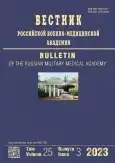Influence of patients’ life priorities on the formation of attitudes toward the organization of medical care provided in outpatient settings
- Authors: Martirosov A.V.1,2, Karailanov M.G.3, Cherkasov S.N.1, Fedyaeva A.V.1, Moroz I.N.4
-
Affiliations:
- V.A. Trapeznikov Institute of Control Sciences of the Russian Academy of Sciences
- Moscow Medical University “Reaviz”
- Kirov Military Medical Academy
- Belarusian State Medical University
- Issue: Vol 25, No 3 (2023)
- Pages: 395-402
- Section: Original Study Article
- Submitted: 24.05.2023
- Accepted: 15.07.2023
- Published: 05.10.2023
- URL: https://journals.eco-vector.com/1682-7392/article/view/456461
- DOI: https://doi.org/10.17816/brmma456461
- ID: 456461
Cite item
Abstract
This study analyzed the influence of patients’ life priorities through an anonymous questionnaire survey of 486 patients regarding their attitudes toward the organization of medical care provided in outpatient settings. During the survey, the examinees must arrange the proposed priorities in a hierarchical order of decreasing importance in relation to oneself. The main group (standard life priorities–the number of coincidences of individual life priorities among all structures was > 3) included 231 people. The control group (without standard life priorities–the number of coincidences of these individual life priorities among all structures was < 3) included 255 people. Despite the same integral assessments of the activities of medical organizations providing medical care in outpatient settings, recognized by the main and control groups, and higher ratings regarding the activities of the city (district) administration for the organization of medical care, patients who have standard life priorities had a higher frequency of claims regarding the organization of activities of individual departments of a polyclinic. Most often, such claims were made on the organization of the laboratory service, district service, and narrow specialists. The structure of life priorities had a certain influence on the attitude toward the criteria for choosing a medical organization. External factors, such as geographical accessibility and good reputation, and internal characteristics of a medical organization, such as the presence of competent specialists and a clear organization of work, were of greater importance to patients with standard life priorities. Professionalism and attention, as the main quality of doctors, were more appreciated by patients with standard life priorities. They also had more confidence in the opinions of real patients, more often trusted their experience of communicating with a doctor, and were less critical of reviews of virtual patients, ratings of doctors on the websites of medical organizations, and information presented in the media. Thus, the analysis of patients’ life priorities is an urgent task of public health as a potential opportunity for managerial influence.
Full Text
About the authors
Aram V. Martirosov
V.A. Trapeznikov Institute of Control Sciences of the Russian Academy of Sciences; Moscow Medical University “Reaviz”
Email: dr.martirosov@mail.ru
ORCID iD: 0000-0001-5240-8372
SPIN-code: 1500-8468
MD, Cand. Sci. (Med.)
Russian Federation, Moscow; MoscowMikhail G. Karailanov
Kirov Military Medical Academy
Author for correspondence.
Email: karaylanov@mail.ru
ORCID iD: 0000-0001-6584-9492
SPIN-code: 7110-9788
Scopus Author ID: 23473000300
ResearcherId: J-1471-2016
MD, Dr. Sci. (Med.), associate professor
Russian Federation, Saint PetersburgSergey N. Cherkasov
V.A. Trapeznikov Institute of Control Sciences of the Russian Academy of Sciences
Email: cherkasovsn@mail.ru
ORCID iD: 0000-0003-1664-6802
SPIN-code: 5392-9889
MD, Dr. Sci. (Med.)
Russian Federation, MoscowAnna V. Fedyaeva
V.A. Trapeznikov Institute of Control Sciences of the Russian Academy of Sciences
Email: orgzdravotdel@gmail.com
ORCID iD: 0000-0002-8874-0921
SPIN-code: 4383-7594
MD, Cand. Sci. (Med.)
Russian Federation, MoscowIrina N. Moroz
Belarusian State Medical University
Email: moroz_iri@bk.ru
ORCID iD: 0000-0002-7430-3237
SPIN-code: 2933-9746
MD, Dr. Sci. (Med.)
Belarus, MinskReferences
- Genovese U, Del Sordo S, Pravettoni G, et al. A new paradigm on health care accountability to improve the quality of the system: four parameters to achieve individual and collective accountability. J Glob Health. 2017;7(1):010301. doi: 10.7189/jogh.07.010301
- Shapovalova MA, Anopko VP. Conditions for healthcare reform. In the world of scientific discoveries. 2010;2–4(8):159–160. (In Russ.).
- Meshkov D, Bezmelnitsyna L, Cherkasov S. A data management model for proactive risk management in healthcare. Advances in Systems Science and Applications. 2020;20(1):114–118. doi: 10.25728/assa.2020.20.1.864
- Lisitsyn YuP. Obshchestvennoe zdorov’e i zdravookhranenie: uchebnik. 2nd ed. Moscow: GEOTAR-Media; 2010. 512 p. (In Russ.).
- Cherkasov SN, Kirtadze ID. The impact of life priorities on the self-assessment of the health of the population of senior age groups. Public Health and Health Care. 2019;1:40–43. (In Russ.).
- Cherkasov SN, Kirtadze ID. The influence of life priorities on the quality of life related to health in senior age groups. The Bulletin of Bakoulev Center Cardiovascular Diseases. 2018;19(4):549–553. (In Russ.). doi: 10.24022/18100694-2018-19-4-549-553
- Abramova OV, Cherkasov SN, Sopova IL. Dependence of level of physical activity of students on life priorities. Health & education millennium. 2017;19(3):61–63. (In Russ.).
- Cherkasov SN, Sopova IL, Fedyaeva AV. The structure of life priorities in women of reproductive age as a social determinant of health. In: Socio-hygienic monitoring of public health: materials for the 24th All-Russian Scientific and Practical Conference with International Participation. Kiryushin VA, editor. Ryazan; 2020. P. 53–59.
- Chausov AA, Grebennik TK, Shuvalova MP, Prikhod’ko NA. Zhiznennye tsennosti, opredelyayushchie meditsinskuyu aktivnost’ i tsennostnye orientatsii materei pri ukhode za ikh novorozhdennymi det’mi. Sistema Tsennostei Sovremennogo Obshchestva. 2016;50:213–218. (In Russ.).
- Munro N, Duckett J. Explaining public satisfaction with health-care systems: findings from a nationwide survey in China. Health Expect. 2016;19(3):654–666. doi: 10.1177/0958928713480065
- Saraev AR, Sahibgareeva EH, Cherkasov SN, Sopova IL. Assessment of the social status of a potential consumer as a condition for ensuring high efficiency of the medical organization. Medical Education and Professional Development. 2013;(2–3 (12–13)):131–132. (In Russ.).
- Deev IA, Kobyakova OS, Boykov VA et al. Satisfaction of patients as an indicator of the effectiveness of organizational models of providing medical care in the outpatient sector. Manager Zdravoochranenia. 2020;8:35–40. (In Russ.). doi: 10.37690/1811-0185-2020-8-35-40
- Lehrich BM, Goshtasbi K, Brown NJ. Predictors of Patient Satisfaction in Spine Surgery: A Systematic Review. World Neurosurg. 2021;(146):e1160–e1170. doi: 10.1016/j.wneu.2020.11.125
- Aleksandrova OY, Konovalov OE, Vasilyeva TP, et al. The development of health preservation technologies: from individual to family approach. The Problems of Social Hygiene, Public Health and History of Medicine. 2021;29(6):1470–1474. (In Russ.). doi: 10.32687/0869-866X-2021-29-6-1470-1474
Supplementary files






